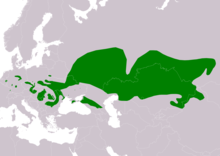European hamster
The European hamster (Cricetus cricetus), also known as the Eurasian hamster,[3] black-bellied hamster[4] or common hamster,[5][6][7] is the only species of the genus Cricetus.[2] It is native to grassland and similar habitats in a large part of Eurasia, extending from Belgium to the Altai mountains and Yenisey River in Russia.[8] Where abundant the animal is considered a farmland pest, and historically it has also been trapped for its fur. It has declined drastically in recent years and is considered critically endangered.[1][9]
| European hamster | |
|---|---|
 | |
| Scientific classification | |
| Kingdom: | Animalia |
| Phylum: | Chordata |
| Class: | Mammalia |
| Order: | Rodentia |
| Family: | Cricetidae |
| Subfamily: | Cricetinae |
| Genus: | Cricetus Leske, 1779 |
| Species: | C. cricetus |
| Binomial name | |
| Cricetus cricetus | |
 | |
| European Hamster range | |
| Synonyms[2] | |
|
List
| |
Description

_Cricetus_cricetus.jpg)
The European hamster has brown dorsal fur with white patches. The chest and belly are black. The tail is short and furred. It is much larger than the Syrian or dwarf hamsters, which are commonly kept as pets. It weighs 220–460 g (7.8–16.2 oz) and can grow to 20–35 cm (8–14 in) long with a tail of 4–6 cm (1.6–2.4 in). Its dental formula is 1.0.0.31.0.0.3.
Behaviour
The common hamster is a nocturnal or crepuscular species. It lives in a complex burrow system. It eats seeds, legumes, root vegetables, grasses and insects. It transports its food in its elastic cheek pouches to the food storage chambers. The storage chambers may be quite large and on average contain 2–3 kg (4.4–6.6 lb) of food, but exceptionally can be up to 65 kg (143 lb).[10][11] It hibernates between October and March. During this time, it wakes every five to seven days to feed from the storage chambers. The adults reach sexual maturity when they are about 43 days old and breed from early April to August. The gestation period is 18–20 days and the size of the litter ranges from three to 15 young, which are weaned when aged three weeks. They are usually solitary animals.[10]
Distribution and conservation status
It is typically found in low-lying farmland with soft loam or loess soils, although it may also inhabit meadows, gardens or hedges. It is found from Belgium and Alsace in the west, to Russia in the east, and Bulgaria in the south.
In captivity, the European hamster has an unusually long lifespan, living up to eight years.
The Court of Justice in Luxembourg, the European Union's highest court, ruled in 2011 that France had failed to protect the European hamster.[12] The court said that if France did not adjust its agricultural and urbanisation policies sufficiently to protect it, the government would be subject to fines of up to $24.6 million.[13] By 2014, France had started a captive-breeding program, which aimed to release 500 hamsters each year into fields that farmers were paid not to harvest.[14]
In 2020, the European hamster was classified as critically endangered across its global range by the IUCN Red List. Although the reasons for its drastic decline are not fully understood, it has been linked especially to habitat loss (for example due to intensive agricultural practices and the building of roads that fragment populations), but also pollution (even light pollution appears to significantly reduce local populations, unless counterbalanced by other factors), climate change and the historical fur trapping.[1]
References
- Banaszek, A.; Bogomolov, P.; et al. (2020). "Cricetus cricetus". IUCN Red List of Threatened Species. 2020. Retrieved 9 July 2020.CS1 maint: ref=harv (link)
- Musser, G.G.; Carleton, M.D. (2005). "Superfamily Muroidea". In Wilson, D.E.; Reeder, D.M (eds.). Mammal Species of the World: A Taxonomic and Geographic Reference (3rd ed.). Johns Hopkins University Press. p. 1043. ISBN 978-0-8018-8221-0. OCLC 62265494.
- "Eurasian hamster". The Free Dictionary. Retrieved 26 April 2013.
- "Cricetus Cricetus – Common or Black-Bellied Hamster". AgroAtlas. Retrieved 26 April 2013.
- "Common Hamster: Cricetus Cricetus" (PDF). Habitats Directive. European Commission. Retrieved 26 April 2013.
- "hamster". Oxford Dictionaries. Oxford University Press. Retrieved 26 April 2013.
- "Cricetus Cricetus". IUCN Red List of Threatened Species. Retrieved 26 April 2013.
- "Cricetus cricetus". Animal Diversity Web. University of Michigan. Retrieved 26 April 2013.
- Dell'Amore, Christine (18 July 2020). "World's rarest wild hamster is now critically endangered". National Geographic.
- MacDonald, David; Priscilla Barret (1993). Mammals of Britain & Europe. 1. London: HarperCollins. pp. 236–237. ISBN 0-00-219779-0.
- Weinhold, U. (8 July 2008), Draft European Action Plan For the conservation of the Common hamster (Cricetus cricetus, L. 1758) (PDF), Convention on the Conservation of European Wildlife and Natural Habitats, Standing Committee, 28th meeting Strasbourg, 24-27 November 2008
- "C-383/09 - Commission v France". InfoCuria. 9 June 2011.
- Erlanger, Steven (9 June 2011). "France Is Scolded Over Care of Great Hamster of Alsace". The New York Times. ISSN 0362-4331. Retrieved 10 June 2011.
- Rauber, paul (July–August 2014). "Wild Hamsters of Alsace". Sierra Club. Retrieved 2 July 2020.
See also


